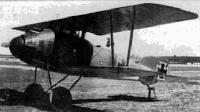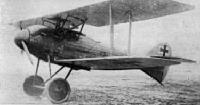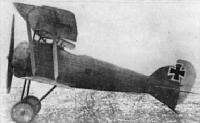Фотографии
-
Determined to get a successful design into production again Tantzen concentrated on developing the D-l and D-II. The result was the D-III, but only five were built.
Самолёты на фотографии: LFG Roland D.I/D.II/D.III - Германия - 1916
-
Самолёты на фотографии: LFG Roland D.I/D.II/D.III - Германия - 1916
-
Determined to produce aircraft of their own design, L.F.G. appointed an engineer named Tantzen as head designer in 1914, and it was he who was responsible for the " Roland" line. His first design, the C-II Walfish, was a sleek streamlined aeroplane but pilot-visibility was poor and it was dropped in favour of the D-I Haifisch.
Самолёты на фотографии: LFG Roland D.I/D.II/D.III - Германия - 1916
-
Only a small number of D-Is were constructed, and it was followed by the D-II Haifisch.
Самолёты на фотографии: LFG Roland D.I/D.II/D.III - Германия - 1916
-
The L.F.G. Arrow was followed by the Taube.
Самолёты на фотографии: Etrich Taube - Австро-Венгрия - 1910
-
Determined to produce aircraft of their own design, L.F.G. appointed an engineer named Tantzen as head designer in 1914, and it was he who was responsible for the " Roland" line. His first design, the C-II Walfish, was a sleek streamlined aeroplane but pilot-visibility was poor and it was dropped in favour of the D-I Haifisch.
Самолёты на фотографии: LFG Roland C.II - Германия - 1915
-
Meanwhile Tantzen had not been idle and had designed another scout, the C-III, the prototype of which, and the L.F.G. plant, was destroyed by fire in 1915.
Самолёты на фотографии: LFG Roland C.II - Германия - 1915
-
The Luftfahrzeug-Gesellschaft (L.F.G.) Company was founded in 1912 by Major von Parseval primarily to build airships of his own design. A small factory wa also established in Johannisthal for the construction of aeroplanes, and the first design completed was the L.F.G. Arrow, a biplane powered by a 95-h.p. Mercedes engine.
Самолёты на фотографии: LFG Roland Stahl-Pfeil - Германия - 1913
-
Although the emphasis at L.V.G. was on building single-engined scouts the world 's first twin-engined bomber, the Roland G-I, was constructed by the company in 1915. It was powered by two Basse & Selve engines of 150 h.p. each mounted in the fuselage and driving the wing-mounted propellers by means of chains.
Самолёты на фотографии: LFG Roland G.I - Германия - 1915
-
While a new factory was being readied in Berlin three float plane were designed and constructed at the L.F.G. plant at Warnemunde on the Baltic Sea. They were the Nr.509; the Nr.750 and the Nr.943 (photo). All three were unsuccessful.
Самолёты на фотографии: LFG Roland W / WD - Германия - 1916
-
While a new factory was being readied in Berlin three float plane were designed and constructed at the L.F.G. plant at Warnemunde on the Baltic Sea. They were the Nr.509 (photo); the Nr.750 and the Nr.943. All three were unsuccessful.
Самолёты на фотографии: LFG Roland W / WD - Германия - 1916
-
While a new factory was being readied in Berlin three float plane were designed and constructed at the L.F.G. plant at Warnemunde on the Baltic Sea. They were the Nr.509; the Nr.750 (photo) and the Nr.943. All three were unsuccessful.
Самолёты на фотографии: LFG Roland W / WD - Германия - 1916
-
After this abortive attempt Tantzen returned to designing scouts and in 1917 the C-V (photo), powered by a 150-h.p. Benz, and the C-VIII, powered by a 220-h.p. Mercedes, were built. Both types were unsuccessful and the German Air Ministry ordered the L.F.G. company to build the Halberstadt CL-IV and the Hannover CL-IIa under licence.
Самолёты на фотографии: LFG Roland C.V/C.VIII - Германия - 1917
-
After this abortive attempt Tantzen returned to designing scouts and in 1917 the C-V, powered by a 150-h.p. Benz, and the C-VIII (photo), powered by a 220-h.p. Mercedes, were built. Both types were unsuccessful and the German Air Ministry ordered the L.F.G. company to build the Halberstadt CL-IV and the Hannover CL-IIa under licence.
Самолёты на фотографии: LFG Roland C.V/C.VIII - Германия - 1917
-
Meanwhile L.F.G. had developed a new method of aircraft construction called "Klinkerrumpf" that saved both time and money. This method was used on all Rolands from the D-IV (photo) to the D-XV/2. The D-IV, Tantzen's first triplane, was powered by a 160-h.p. Mercedes, but was dropped in favour of the Fokker and Pfalz triplanes.
Самолёты на фотографии: LFG Roland D.IV - Германия - 1917
-
Third version, the XV/3 (photo), was practically a new design and comparison of the two photographs show the differences in these machines. Two airframes were constructed, one with a 200-h.p. Benz IIIaV and the other with a 185-h.p. BMW.
Самолёты на фотографии: LFG Roland D.VI/D.VII/D.XIII/D.XV - Германия - 1918
-
The D-VI was extensively modified before entering production and as the VIa (photo) was powered by a 180-h.p. Mercedes ; the VIb had a 150-h.p. Benz and larger tail surfaces and went into production.
Самолёты на фотографии: LFG Roland D.VI/D.VII/D.XIII/D.XV - Германия - 1918
-
Some Vlb were fitted with modified ailerons and a 200-h.p. Benz engine.
Самолёты на фотографии: LFG Roland D.VI/D.VII/D.XIII/D.XV - Германия - 1918
-
Two versions of the D-VII were constructed. One, the D-VII/1 (photo) was powered by a 200-h.p. Benz III, while the other model, the D-VII/2 had a 200-h.p. Benz IIIb.
Самолёты на фотографии: LFG Roland D.VI/D.VII/D.XIII/D.XV - Германия - 1918
-
The D-X, D-XI and D-XII were projects, and the D-XIII was a D-Vll with a 195-h.p. Korting III in place of the original Benz.
Самолёты на фотографии: LFG Roland D.VI/D.VII/D.XIII/D.XV - Германия - 1918
-
Next in the Roland line was the D-XV. The XV/1 (photo) was powered by a 160-h.p. Mercedes and a second version, the XV/2 had single strut in place of the normal twin struts.
Самолёты на фотографии: LFG Roland D.VI/D.VII/D.XIII/D.XV - Германия - 1918
-
Three versions were constructed, the IX/1 powered by a 160-h.p. Siemens Sh3 engine driving a four-bladed propeller; the IX/2 with a 210-h.p. Siemens Sh3a driving a two-bladed propeller; and the IX/3 (photo) with the same engine as the lX/2 but fitted with a larger rudder.
Самолёты на фотографии: LFG Roland D.IX/D.XIV - Германия - 1918
-
The D-XIV was a D-IX/1 powered by a 170-h.p. Goebel Goe III engine.
Самолёты на фотографии: LFG Roland D.IX/D.XIV - Германия - 1918
-
Last of the Roland scouts were the D-XVI powered by either a 160-h.p. Siemens Sh II (photo) or a 170-h.p. Goebel III, and the D-XVIII, powered by a 185-h.p. BMW.
Самолёты на фотографии: LFG Roland D.XVI/D.XVII - Германия - 1918
-
Last of the Roland scouts were the D-XVI powered by either a 160-h.p. Siemens Sh II or a 170-h.p. Goebel III (photo), and the D-XVIII, powered by a 185-h.p. BMW.
Самолёты на фотографии: LFG Roland D.XVI/D.XVII - Германия - 1918
-
Last of the Roland scouts were the D-XVI powered by either a 160-h.p. Siemens Sh II or a 170-h.p. Goebel III, and the D-XVIII (photo), powered by a 185-h.p. BMW.
Самолёты на фотографии: LFG Roland D.XVI/D.XVII - Германия - 1918
Статьи
- -
- Air Pictorial's photo-review
- Photos by request
- The journal of a roving spotter
- ??? - Central Aircraft Company C/F 2A, Centaгr 2A
- B.Robertson - U.S. Aircraft in the British Services 1914-1955 (6)
- H.Nowarra - Portraits of the Roland Family
- J.Orwovski - Poland's Nation Aviation Day
- J.Stevens - The Propeller and the Pure Jet
- R.Cross - Convair's B-58 Hustler

























